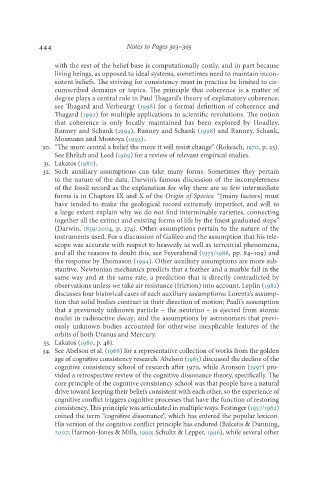Page 461 - Deep Learning
P. 461
444 Notes to Pages 303–305
with the rest of the belief base is computationally costly, and in part because
living beings, as opposed to ideal systems, sometimes need to maintain incon-
sistent beliefs. The striving for consistency must in practice be limited to cir-
cumscribed domains or topics. The principle that coherence is a matter of
degree plays a central role in Paul Thagard’s theory of explanatory coherence;
see Thagard and Verbeurgt (1998) for a formal definition of coherence and
Thagard (1992) for multiple applications to scientific revolutions. The notion
that coherence is only locally maintained has been explored by Hoadley,
Ranney and Schank (1994), Ranney and Schank (1998) and Ranney, Schank,
Mosmann and Montoya (1993).
30. “The more central a belief the more it will resist change” (Rokeach, 1970, p. 23).
See Ehrlich and Leed (1969) for a review of relevant empirical studies.
31. Lakatos (1980).
32. Such auxiliary assumptions can take many forms. Sometimes they pertain
to the nature of the data. Darwin’s famous discussion of the incompleteness
of the fossil record as the explanation for why there are so few intermediate
forms is in Chapters IX and X of the Origin of Species: “[many factors] must
have tended to make the geological record extremely imperfect, and will to
a large extent explain why we do not find interminable varieties, connecting
together all the extinct and existing forms of life by the finest graduated steps”
(Darwin, 1859/2004, p. 274). Other assumptions pertain to the nature of the
instruments used. For a discussion of Galileo and the assumption that his tele-
scope was accurate with respect to heavenly as well as terrestrial phenomena,
and all the reasons to doubt this, see Feyerabend (1975/1988, pp. 84–109) and
the response by Thomason (1994). Other auxiliary assumptions are more sub-
stantive. Newtonian mechanics predicts that a feather and a marble fall in the
same way and at the same rate, a prediction that is directly contradicted by
observations unless we take air resistance (friction) into account. Leplin (1982)
discusses four historical cases of such auxiliary assumptions: Lorentz’s assump-
tion that solid bodies contract in their direction of motion; Pauli’s assumption
that a previously unknown particle – the neutrino – is ejected from atomic
nuclei in radioactive decay; and the assumptions by astronomers that previ-
ously unknown bodies accounted for otherwise inexplicable features of the
orbits of both Uranus and Mercury.
33. Lakatos (1980, p. 48).
34. See Abelson et al. (1968) for a representative collection of works from the golden
age of cognitive consistency research. Abelson (1983) discussed the decline of the
cognitive consistency school of research after 1970, while Aronson (1997) pro-
vided a retrospective review of the cognitive dissonance theory, specifically. The
core principle of the cognitive consistency school was that people have a natural
drive toward keeping their beliefs consistent with each other, so the experience of
cognitive conflict triggers cognitive processes that have the function of restoring
consistency. This principle was articulated in multiple ways. Festinger (1957/1962)
coined the term “cognitive dissonance”, which has entered the popular lexicon.
His version of the cognitive conflict principle has endured (Balcetis & Dunning,
2007; Harmon-Jones & Mills, 1999; Schultz & Lepper, 1996), while several other

